Recording history to save it
A famous wreck is the steamboat Arabia that sank in 1856.
“They had everything from shoes and boots – there were 4,000 of them – all sorts of sets of dishes, kegs of different size nails, picks, any kind of tool,” said Dr. Neal Lopinot. “Really it was a steamboat full of merchandise that was going out to the frontier. Some of it was nice stuff, too, but most of it was utilitarian.”
Lopinot is a research archaeologist and director of Missouri State University’s Center for Archaeological Research, or CAR. Ensuring that such remains are not destroyed is one of the many projects that keep the doors open at CAR.
The center is a research institute that conducts archaeological field work and other cultural resource management projects on a contractual basis, primarily for government agencies.
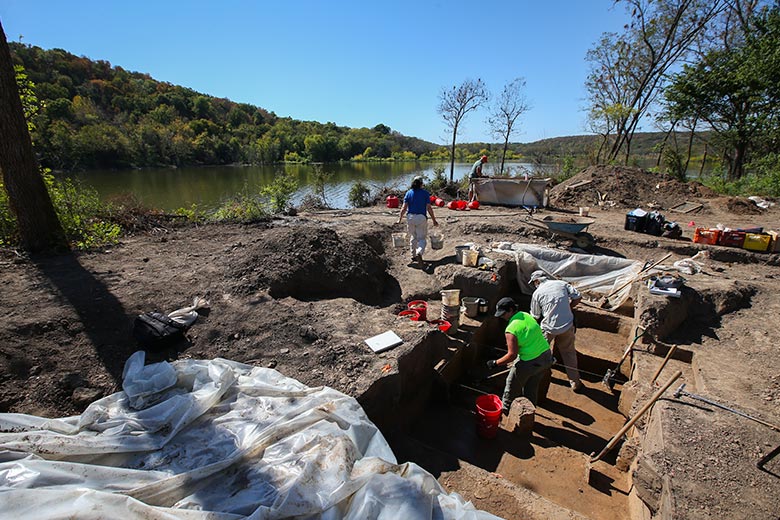
The excavation team makes progress at the Oklahoma dig site. They planned to go down to about 3.1 meters, and stand about 1.6 meters deep.
Preserving steamboat wrecks
Since 2012, CAR has been employed to survey several former islands along the Missouri River where the United States Fish and Wildlife Service and Army Corps of Engineers wanted to dig trenches to recreate spawning grounds for the endangered pallid sturgeon.
“They’ve lost their primary spawning grounds so the population’s diminished; they’re trying to recreate that,” said Lopinot. “Not just for the pallid sturgeon, but that was the main focus of it; but there are lots of other fish that also spawn in those kinds of situations. Also it increases wildlife habitat, wetlands.”
Before the trenches were dug, Lopinot and a team of researchers from CAR used magnetometry to see if there were any steamboat wrecks in those areas. They found the remains of at least one boat.
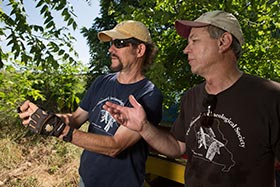
Dr. Neal Lopinot and Jack ray examine an artifact
“They decided to move the trench to avoid impacting the buried steamboat wreck,” he said. “Just about every steamboat wreck is considered to be eligible for the National Register of Historic Places, which means they’d probably have to mitigate it, which in turn means a major and very costly excavation.”
Lopinot is the primary person writing proposals and responding to requests from agencies that want to hire a group to undertake archaeological surveys and excavations. The center raises an average of about $250,000-300,000 a year in grants and contracts.
Many of CAR’s projects are work that is required by the National Historic Preservation Act. The search for steamboat remains was based on Section 106 – it involves finding out if there are any significant archaeological remains in a specific area before any work is done that might disturb the remains.
Another type of research is based on Section 110 – documenting and preserving archaeological sites. CAR has recently been involved in Section 110 research at the Three Finger Bay site on the Gibson Reservoir in northeast Oklahoma. Prior studies have found archaeological remains on a finger of land extending into the reservoir. CAR researchers have been excavating a section to determine the significance of the site.
The center has been involved in a number of prominent archaeological studies including Big Eddy, Delaware Town and the Trail of Tears.
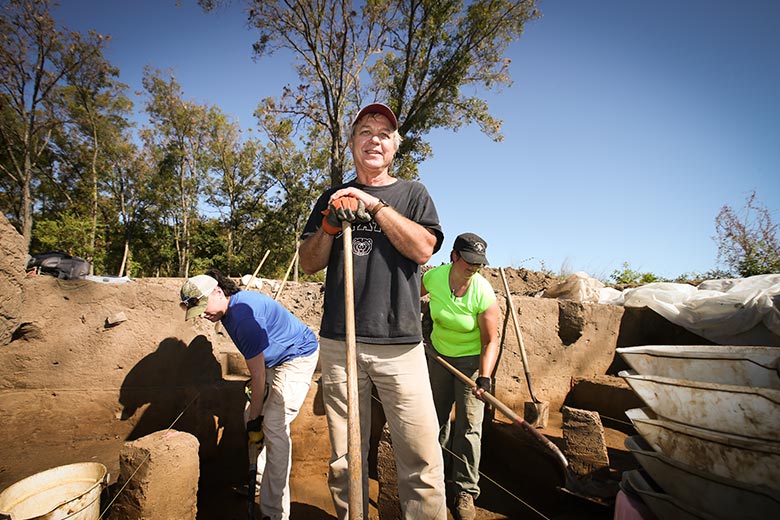
Dr. Lopinot and his team digging at the excavation site in Oklahoma
Digging in the dirt
On a beautiful fall day in the Ozarks, Lopinot spent the day digging in the dirt – one of his favorite parts of his job. Along with CAR Project Supervisor Dustin Thompson and three other archaeologists (including two MSU alums), the team methodically skimmed dirt from an excavation area and then sifted through the dirt to find any artifacts.
On that day, the main part of the excavations was down about 1.6 meters deep and they planned to go down to 3.1 meters.
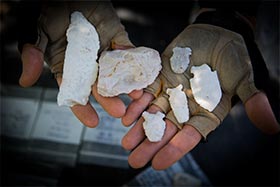 “It looks like the site was intensively occupied during what we call the Middle Woodland Period – about 100 BC to AD 400. There are other periods represented as well,” said Lopinot. “We’re going to dig a lot deeper, and we’re hoping that we find much earlier deposits that are relatively un-mixed. Hopefully there’ll be a little charcoal that we can radiocarbon date.”
“It looks like the site was intensively occupied during what we call the Middle Woodland Period – about 100 BC to AD 400. There are other periods represented as well,” said Lopinot. “We’re going to dig a lot deeper, and we’re hoping that we find much earlier deposits that are relatively un-mixed. Hopefully there’ll be a little charcoal that we can radiocarbon date.”
Stone artifacts cannot be dated because the method requires carbon from formerly living plants and animals. At this site, they have been looking for plant remains such as hickory nutshell fragments or wood that has been carbonized. Bones and shells can also be dated because they are also from once-living animals. In dating stone artifacts, for example, an archaeologist tries to find dateable materials as close vertically and horizontally to those artifacts, documenting the precise location of each.
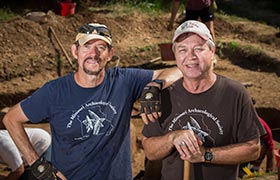 Lopinot and Jack Ray, CAR assistant director and research archaeologist, recently had some of their research from the Big Eddy site near Stockton, Missouri, published in the “Proceedings of the National Academy of Sciences” and Lopinot was the principal author of an article published on the construction of Monks Mound, the largest mound at the largest site in North America, in the “Midcontinental Journal of Archaeology.”
Lopinot and Jack Ray, CAR assistant director and research archaeologist, recently had some of their research from the Big Eddy site near Stockton, Missouri, published in the “Proceedings of the National Academy of Sciences” and Lopinot was the principal author of an article published on the construction of Monks Mound, the largest mound at the largest site in North America, in the “Midcontinental Journal of Archaeology.”


Good stuff!
The CAR is an MSU gem.